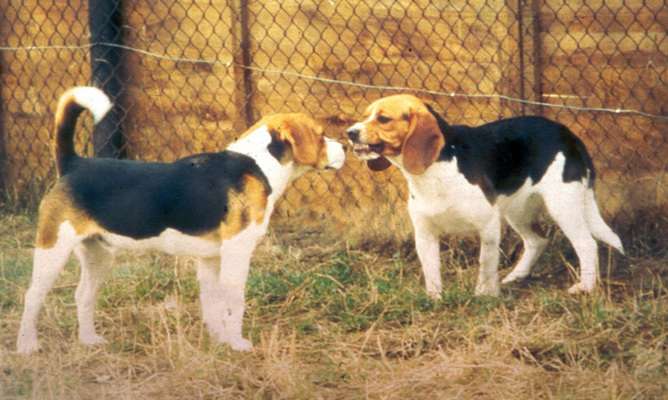Who's top dog? New research sorts dominant and submissive canine poses

In the first quantitative study on status behaviour in a stable group of domestic dogs, Dutch researchers have identified and categorised dog behaviours most consistently associated with dominance and submission.
The new study, published today in the journal PLOS ONE, adds some quantitative data to a debate usually infused with opinion.
The researchers found that the concept of dominance does apply to domestic dogs and that certain behaviours, regardless of context, are good indicators of the dog's status.
"The best indicator for status assessment in a pair of individuals, as well as for the position in the group (rank order), is submission, not aggression," said lead researcher, Joanne van der Borg, a behavioural biologist at Wageningen University in the Netherlands.
"The best formal submission signal is body tail wag, often shown in combination with mouth lick. Lowering of posture is the best status indicator for most relationships. The tail position is the most informative body part of dogs for the assessment of status in relationships."
Lessons for dog owners
Janice Lloyd, Senior Lecturer in Animal Behaviour at James Cook University said dominance-submissive relationship only exists when one dog consistently submits to the other. "Once the relationship is established, it is reinforced through warning postures and ritualistic aggressive encounters, rather than full-blown fighting," she said.
Aggressiveness and social dominance are not the same thing she said, adding that postural displays can provide more information about status and rank than aggressiveness alone.
"I think it is important to note that the paper analysed dominance through behavioural measures and that dominance was used as a variable. It is uncertain if the 'concept of dominance' is useful to explain dog–dog aggression or dog-human aggression," said Lloyd, who was not involved in the study.
"Although dominance-submissive relationships exist among some pet dogs (and probably cats), a linear hierarchy may not exist as individuals can share similar ranks and an animal will guard only what is important to it."
The dominance-submissive model is not that relevant for most of the behaviours dog owners want from their dogs, she said.
"Most aggressive behaviour seen in dogs is caused by fear and/or anxiety rather than dominance. It would be ill-advised for a dog owner to think that there was one or two dog postures identified in the paper that would be most likely to predict a dog that was about to be aggressive," she said.
Visual cues that indicate fear include blinking, licking, turning away, moving away and – if the perceived threat is not removed – growling, snapping and possibly biting, she said.
"My advice is for dog owners to learn as much as they can about canine body language and avoid putting their dogs into situations where the 'ladder of aggression' may escalate. If owners believe that an individual dog has a 'dominance-trait' that drives it to achieve a high rank, this might lead to coercive and punishment-based techniques, in order for the owner to erroneously try to 'show the dog who is boss', which can exacerbate the problem and ruin the owner-pet relationship."
Journal information: PLoS ONE
Source: The Conversation
This story is published courtesy of The Conversation (under Creative Commons-Attribution/No derivatives).
![]()

















